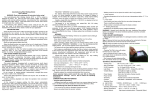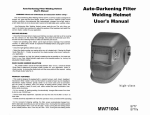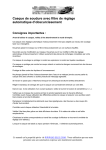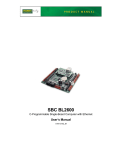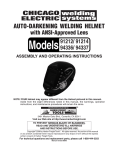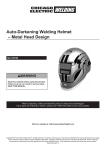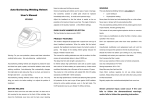Download ATD Tools ATD-3721 User's Manual
Transcript
ATD-3721 XL "SOLAR" AUTO-DARKENING HELMET READ & UNDERSTAND ALL INSTRUCTIONS BEFORE USING The ATD Auto-Darkening Welding Helmet is designed to protect the eyes and face from sparks, spatter, and harmful radiation under normal welding conditions. The auto-darkening filter automatically changes from a light state to a dark state when an arc is struck, and it returns to the light state when welding stops. The ATD auto-darkening welding helmet comes ready for use. The only thing you need to do before you weld is to adjust the position of the headband and select the correct shade number for your application. WARNING: z z z z The ATD auto-darkening welding helmet is not suitable for laser welding & oxyacetylene welding / cutting processes. Never place the ATD helmet or the auto-darkening filter on a hot surface. Never open or tamper with the auto-darkening filter. The ATD auto-darkening welding helmet will not protect against severe impact hazards, z including grinding disks. Never use for grinding. This ATD helmet will not protect against explosive devices or corrosive liquids. Do not make any modifications to either the filter or helmet, unless otherwise specified in this manual. Do not use replacement parts other than those specified in this manual. Unauthorized modifications or replacement parts will void the warranty and expose the operator to the risk of personal injury. Should the ATD helmet not darken upon striking an arc, stop welding immediately and contact your supervisor or your dealer. Do not immerse the filter in water. Do not use any solvents on filters’ screen or helmet components. z Use only at temperatures: -5°C ~ +55°C (23°F ~ 131°F). z Storing temperatures: -20°C ~ +70°C (-4°F ~ 158°F). z z Protect filter from contacting liquid and dirt. Clean filters’ surfaces regularly; do not use strong cleaning solutions. Always keep sensors and solar cells clean using a clean lint-free tissue or cloth. Replace the front cover lens immediately if it becomes cracked, scratched or pitted. Never try to open the filter cartridge. z z z z z z WARNING: Severe personal injury could occur if the user fails to follow the above-mentioned warnings, and/or fails to follow the operating instructions. TROUBLESHOOTING z Irregular darkening or dimming Headband has been set unevenly and there is an uneven distance from the eyes to the filter’s lens (Reset the headband to reduce the difference to filter). z Auto-darkening filter does not darken or flickers • • • z Front cover lens is dirty or damaged (change lens cover) Sensors are dirty (clean the sensors’ surface) Welding current is too low (turn the switch to the “slow” position). Slow response Operating temperature is too low (do not use at temperature below -5°C or 23°F). z Poor vision • Front/inside cover lens and/or filter lens are dirty (Clean or change lens) • There is insufficient ambient light • Shade number is set incorrectly (reset the shade number) z Welding helmet slips Headband is not adjusted properly (readjust headband) WARNING: User must stop using the auto-darkening welding helmet immediately if the above-mentioned problems cannot be corrected, and contact your ATD dealer. INSTRUCTIONS FOR USE WARNING! Before using this helmet for welding ensure you have read and understand the safety instructions z The ATD auto-darkening welding helmet comes assembled but before it can be used it must be adjusted to fit the user properly and set up for response time, sensitivity and shade level. ADJUSTING THE FIT OF THE HELMET z The overall circumference of the headband can be made larger or smaller by rotating the knob on the back of the headband. (See adjustment “Y” in fig.1) This can be done while wearing the helmet to allow just the right tension to be set to keep the helmet firmly on the head without it being too tight. z If the headband is riding too high or too low on your head adjust the strap that passes over the top of your head. To do this, release the end of the band by pushing the locking tab out of the hole in the band. Slide the two portions of the band to a greater or lesser width as required and push the locking tab through the nearest hole. (See adjustment “W” in fig.1) z Test the fit of the headband by lifting up and closing down the helmet a few times while wearing it. If the headband moves while tilting re-adjust it until it is stable. ADJUSTING DISTANCE BETWEEN HELMET & FACE z Loosen the block nut to adjust the distance between the helmet and your face with the helmet in the down position. z Loosen the block nut on either side of the helmet and slide it nearer to or further from your face. It is important that your eyes are each the same distance from the lens otherwise the darkening effect may appear uneven. z Re-tighten the block nut when adjustment is complete. ADJUSTING ANGLE OF THE MASK IN THE DOWN POSITION z If the lens is not properly aligned with the eyes in the down position the mask angle can be further adjusted into one of three preset positions using the tilt plate shown in fig.2. Behind each pivot knob on the sides of the helmet there is a screw that passes through the side of the mask and into one of the holes in the tilt plate (see A, B, C in fig.2). Partially loosen each screw counter-clockwise so that it withdraws out of the tilt plate but remains in the side of the mask. Rotate the headband assembly so that one of the alternative positions is aligned with the end of the screw. Turn the screws clockwise again so that they pass through the holes thus fixing the position of the tilt plate. SELECTING SHADE LEVEL z Select the shade level you require according to the welding process you will use by referring to the shade guide table below for settings. Turn the shade control knob on the back of the shade cartridge to the shade number required.(See fig 3) SELECTING DELAY TIME z When welding ceases the viewing window automatically changes from dark to light but with a pre-set delay to compensate for any bright after glow on the work piece. The delay time/response can be set to "fast" (0.25 to 0.35 seconds) or "slow" (0.5 to 0.8 seconds) as you require by using the microswitch on the back of the shade cartridge. (See fig.3) ADJUSTING THE SENSITIVITY z The sensitivity can be set to “high” or “low” using the microswitch on the back of the shade cartridge. The “high” setting is the normal setting for everyday use. Where the operation of the mask is disturbed by excess ambient light or another welding machine close by, use the “low” setting. (See fig.3) You are now ready to use your ATD auto-darkening welding helmet! The shading may be adjusted during use by turning the potentiometer control. MAINTENANCE REPLACING FRONT OR REAR COVER LENS. z When the front or rear cover lens becomes damaged (cracked, scratched, stained or pitted) you must replace it. Place your finger or thumb into the recess at the bottom edge of the window and flex the window upwards until it releases from one edge. (Replacement of front cover lens is shown below in fig.4) CHANGING THE SHADE CARTRIDGE. (See figs.5a & 5b) FITTING NEW CARTRIDGE. z Take the new shade cartridge and pass the potentiometer cable under the plastic retainer before dropping the cartridge into its retaining frame inside the helmet. Cover the plastic retainer and ensure that the screws are properly close as shown in fig.5b. z CLEANING: Clean helmet by wiping with a soft cloth. Clean cartridge surfaces regularly. Do not use strong cleaning solutions. Clean sensors and solar cells with denatured alcohol and a clean cloth and wipe dry with a lint-free cloth. TECHNICAL SPECIFICATIONS Viewing Area: Size of Cartridge: UV/IR Protection: Light State: Variable Shade: Power Supply: Power On/Off: Sensitivity: Switching Time: Delay time: 100 x 60 mm 114 x 133 x10 mm Up To Shade DIN16 at all times. DIN 4 DIN 9 to 13 Solar cells, Battery included Fully Automatic Adjustable 1/25000 sec. From light to dark 0.2 ~ 0.8s Operating Temperature: -5°C to + 55°C (23°F to 131°F) Storing Temperature: -20°C to + 70°C (-4°F to 158°F) Helmet Material: Total Weight: High-impact resistant plastic / ABS 750g SHADE GUIDE TABLE Note: SMAW – Shielded Metal Arc Welding SAW – Shielded Semi-Automatic Arc Welding PAW – Plasma Arc Welding PAC – Plasma Arc Cutting MIG (Heavy) – MIG on Heavy Metals TIG, GTAW – Gas Tungsten Arc Welding MIG (Light) – MIG on Light Alloys MAG/CO2 – Metal Active Gas







